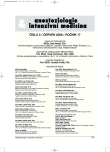A comparison of haemodynamic changes using thoracic epidural anesthesia versus standard balanced anaesthesia during on-pump coronary artery bypass grafting
Authors:
M. Stříteský 1; D. Rubeš 1; M. Semrád 2; T. Čermák 1; M. Lipš 1
Authors‘ workplace:
Klinika anesteziologie, resuscitace a intenzivní medicíny VFN a 1. LF UK v Praze
1; II. chirurgická klinika kardiovaskulární chirurgie VFN a 1. LF UK v Praze
2
Published in:
Anest. intenziv. Med., 17, 2006, č. 3, s. 138-144
Category:
Anaesthesiology - Original Paper
Overview
Background:
Thoracic epidural anaesthesia is a method with a short history starting in the early eighties. Its use in cardiac surgery patients is presumed to reduce peri-operative and early post-operative ischaemia, provide superior analgesia, shorten re-warming and extubation times and improve ventilation parameters.
Materials and Methods:
A total of 30 patients undergoing CABG under general anaesthesia were randomized to the thoracic epidural group (N = 15) and plain general anaesthesia group (N = 15).We observed haemodynamic parameters (HR, BP, CI, SVRI, LVSWI), markers of analgesia, extubation time, time till awake and early post-operative complication rates. Student’s and MANOVA tests were used for statistical analysis. P values less than 0.05 were considered significant.
Results:
We observed a lower heart rate and mean systemic pressure in the epidural anaesthesia group while the cardiac index remained equal. Patients in the thoracic epidural group had better visual analgesic score and shorter awakening and extubation times.
Conclusion:
Thoracic epidural anaesthesia provides stable conditions in cardiac surgery. It can be used as one of the fast-track methods.
Key words:
ischaemia – cardiac surgery – ventilation parameters
Labels
Anaesthesiology, Resuscitation and Inten Intensive Care MedicineArticle was published in
Anaesthesiology and Intensive Care Medicine

2006 Issue 3
Most read in this issue
- Surfactant – use in adult patients
- A comparison of haemodynamic changes using thoracic epidural anesthesia versus standard balanced anaesthesia during on-pump coronary artery bypass grafting
- Assessment of regional tissue perfusion by indicator microdialysis technique
- Assessment of performance of NMT stimulators used during anaesthesia in the Czech Republic
